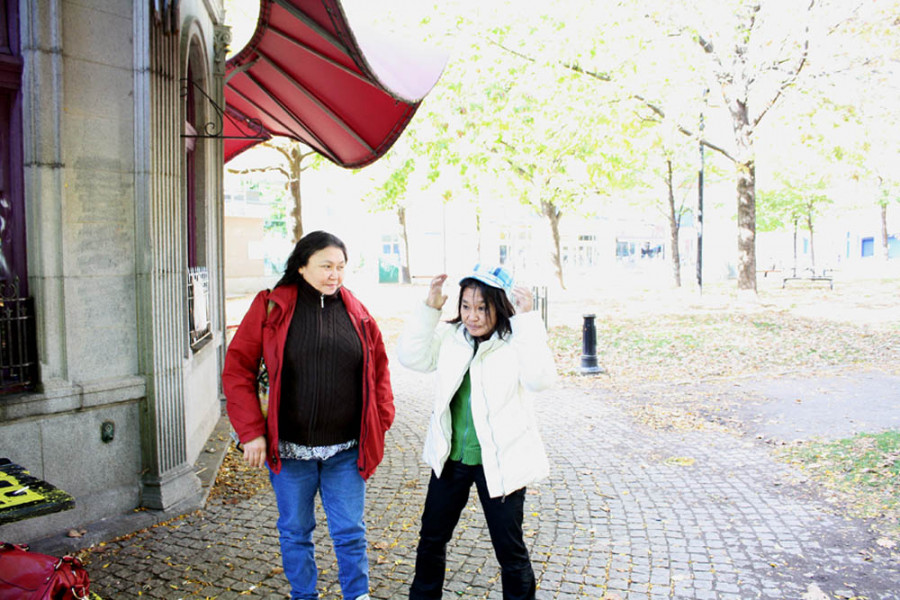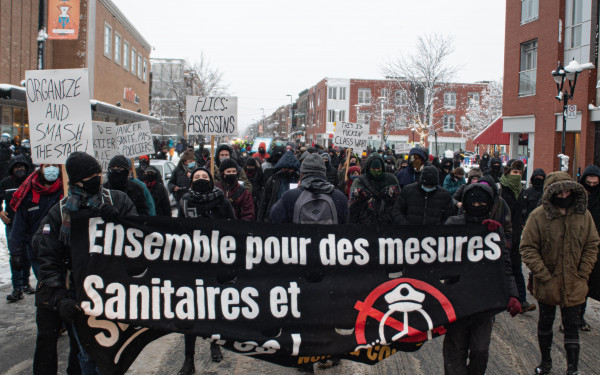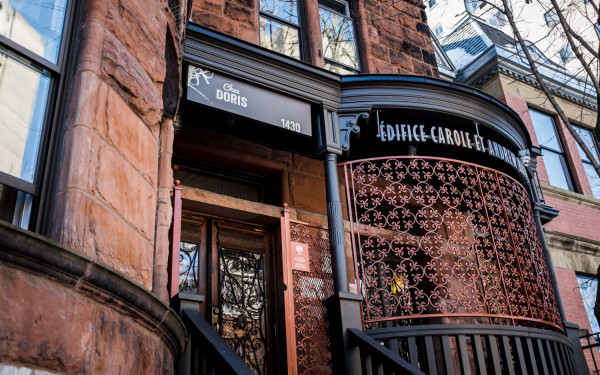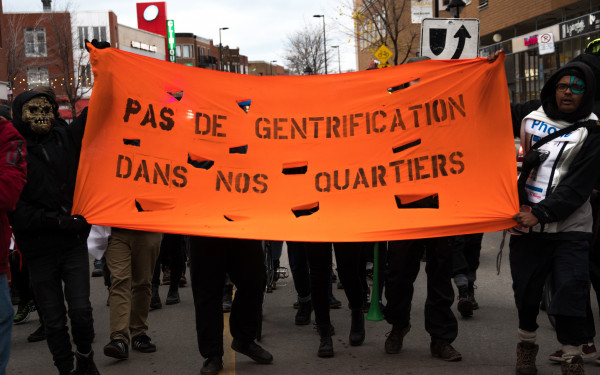No Place for the Homeless
New Shaughnessy Village Condos to Transform Neighbourhood
Young couples line up around the block. The line stretches along a steel fence on Ste. Catherine Street past a heap of rubble that used to be an Indian restaurant. Gradually, they trickle out of the warm September night into a showroom on Lambert Closse Street.
Ordinarily, it’s conceivable these people might have avoided the area altogether. For the past 15 years, the western edge of downtown Montreal, also known as Shaughnessy Village, has been decaying. The very block they stand on has been abandoned for three years.
Tonight, each couple is buying up a condo unit in the area’s newest phoenix: Le Seville. Before the showroom closes, every available unit in the building is sold.
Across the street an entirely different scene is unfolding. The neighborhood’s homeless and working poor gather in Cabot Square, where they have struck an uneasy truce with local police.
Every night they gather in the small park to socialize and maybe drink a few beers. As long as the bottles are kept out of sight and the socializing doesn’t extend too far beyond the park, police officers don’t generally intervene.
But Shaughnessy Village is undergoing a series of changes that will completely transform the area and threatens to push the local homeless population further from the city core.
Social Housing to the
Wayside
Le Seville is a $112 million, 450-unit condo development that will be erected on the site of the once thriving Seville Theatre. Since the Seville shut its doors in 1985, the neighbourhood went through a quick decline that saw the Montreal Canadiens relocate their arena downtown and entire blocks of businesses fold.
In 2004, Claridge Investments bought the Seville along with the other buildings on the same city block for $10 million.
Claridge’s majority shareholder is Stephen Bronfman, whose family founded Seagram’s and once owned the Montreal Canadiens.
By 2009, Claridge, ACDF Architecture and urban design firm Groupe Cardinal Hardy announced plans to convert the block into a three building complex that would include 1,100 rooms reserved for student housing.
This is where one critic claims the project’s fundamental problems arose.
“The city of Montreal requires that any housing development project that exceeds 200 units has to put aside 15 per cent of its units for social housing,” said Eric Michaud, a spokesperson for renter rights group Habiter Montréal. “[Claridge] managed to circumvent that requirement because they were building student housing, which was lacking near downtown Montreal. My fear at the time was that they would change the nature of the project from student housing to condos and still not include social housing.”
Michaud’s fears proved to be prescient.
The student-housing proposal was scrapped later that year. Claridge then enlisted the help of Groupe Prével—a Montreal firm that developed condo projects in former industrial areas Griffintown and St. Henri—and the partners went to work on a new project.
Le Seville was greenlit in April 2010 with no plans to include social housing. As a compromise, Claridge agreed to donate $680,000—about 0.5 per cent of the project’s budget—towards the construction of a homeless shelter or social housing.
“A shelter is not housing,” said Michaud. “It provides only temporary relief instead of long term solutions. And that amount of money can’t sustain a shelter over a long period of time.”
The practice of excluding social housing from a project of this scale is uncommon in Montreal. District Griffin, a $750 million condo development located a few blocks south of downtown, will include 275 social housing units. Twenty-five per cent of developer Samcon’s Point St. Charles condos are set aside for the construction of social housing.
Darren Becker, a spokesperson for Montreal Mayor Gerald Tremblay, says Le Seville should be a welcome change for a part of the city that has been “derelict for over a decade.”
“We’re always getting complaints that the city is losing young couples to the suburbs,” said Becker. “But after Le Seville sold out in just one day, I think this proves the contrary.”
In May, Mayor Tremblay announced potential budget shortfalls of $400 million from the city’s coffers. For a city that depends on property taxes to keep afloat, 450 new homeowners is never bad news.
Life in Cabot Square
For the past two years, homelessness has been a growing concern in Shaughnessy Village.
Sylvie Cornez is the director of Chez Doris, a women’s shelter adjacent to Le Seville. She said that lately she is having trouble placing homeless women in overnight shelters.
“Two years ago this wasn’t a problem,” said Cornez. “We wouldn’t leave the office until our clients had a place to sleep that night. We can’t do that anymore.”
Cornez said she welcomes the new development if it means the construction of a new homeless shelter in Montreal.
Back at Cabot Square, the city’s crowded shelters are an all too present reality. Corrie and her sister Christina left their Odjibwe Mohawk reserve north of Ottawa to come Montreal.
“We just wanted to get away,” said Corrie. “To backpack.”
Upon arriving in Montreal on Oct. 7, the sisters were turned aside at two shelters and spent their first two nights sleeping outside in near-freezing temperatures.
Then they met Mary at Cabot Square.
“She took us under her wing,” said Christina. “She introduced us to other indigenous people in the park and showed us a safe place to sleep. It’s like a community here.”
Mary came to Montreal from Salluit, one of Quebec’s northern most Inuit communities, over 27 years ago. She spent most of that time living on the streets, including a 10-year period where she was in and out of jail.
For Mary, Cabot Square is a place she can be with other indigenous women without being frequently questioned by the police. She said the new development would likely change that.
“We don’t hurt anyone, but the people in those condos won’t want to live across the street from us,” said Mary. “They’ll complain to the police and we’ll be kicked out of the park. Well, this is my park, and I’m never leaving.”
Mary may not be welcome to loiter in Cabot Square for much longer. In October, the city announced plans to “clean up” the park. No figures or plans are currently available, but a similar project aimed at cleaning up Montreal’s Dominion Square has largely eliminated the presence of homeless people in the park since it was completed in 2010.
Becker also told The Link the Mayor’s office was looking into increasing police presence in the area.
The Road Ahead
This week, Mayor Trembley will unveil a new plan to fight homelessness in Montreal.
“I can’t [divulge] the details right now,” said Becker. “But the goal is to come up with more rooming, more social housing and to work closely with the police.”
A pilot project called Equipe mobile reference is already in place and may be expanded as a part of the mayor’s new plan.
EMR has police collaborating with social workers to identify the most commonly arrested homeless people in the city and an alternative solution to simply rearresting them time and time again.
“The idea is not to arrest the problem under the rug,” said Becker. “This is an issue that is close to the mayor’s heart and we want to do whatever we can to fix it, but we need participation from other levels of government.”
Michaud isn’t buying the party line.
“There was an opportunity to increase social housing in Montreal when Le Seville was planned,” he said. “But Habiter Montréal was completely excluded from the process and so was social housing.”
Le Seville will start selling its second phase of condos later this fall. If September’s one-day sellout is any indication of things to come, Claridge can expect its investment to continue paying dividends.
Whether the influx of middle and upper class homeowners into the area is the shot in the arm the Shaughnessy Village has needed for decades or just a social sweep of Montreal’s homeless, the neighbourhood will scarcely resemble itself in just a few years from now.
This article originally appeared in Volume 31, Issue 09, published October 12, 2010.

__900_600_90.jpg)
__900_600_90.jpg)
__700_1054_90.jpg)




_600_375_90_s_c1.jpg)
